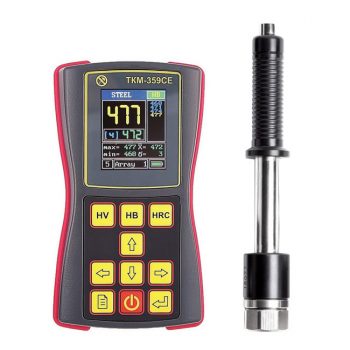
LEEB HARDNESS TESTER TKM‑359CE
Leeb hardness tester is a high-precision hardness tester designed for fast measurements of metal products in laboratory, manufacturing, and field environments.
The Leeb hardness tester is designed for non-destructive quality assurance testing in the fields of metallurgy, mechanical engineering, aircraft, shipbuilding, atomic energy, and oil & gas.
This hardness tester is used to the Leeb technique.
DESCRIPTION
DISTINCTIVE ATTRIBUTES
TECHNICAL PARAMETER
DESCRIPTION
Leeb TKM-359CE Controls Hardness of Following:
- All basic types of metals and alloys without additional calibrations (structural, tool, corrosion-proof, heat-proof, non-corrosive steels and alloys as well as alloys of nonferrous metals, castiron, aluminium, bronze, brass);
- Items with surface hardening and high frequency current hardening;
- Items of complicated configuration;
- Heavy and big items with rough surface.
Exploitation Advantages
- Wide range of controlled metals and alloys.
- Low sensitivity to the curvative and roughness of surface.
- Monitoring of hardness change along the surface.
- Stable measurements independent from force and time of pressing the probe to the surface.
- Possibility of material identification in blank production.
- Control of “volumetric” hardness.
Features of Leeb TKM-359CE:
- Impact-, dust- and water- proof housing;
- Intuitive graphic interface;
- Bright color graphic display allows working at below zero temperature and stays bright at any lighting;
- Signalization of exceeding of prescribed readings threshold;
- Unique system of statistic data processing and averaging of readings;
- Fast adjustment of readings and programming of additional calibrations to basic scales by 2 or less standard blocks;
- Flexible device memory for recording of readings and their analysis;
- Programming of additional scales calibrations of hardness tester by 2 or less standard test blocks;
- Fast programming of additional scales by 2 to 10 standard test blocks.
Probes characteristics
| Photo | Probe Type | Length, mm | Diameter, mm | Application |
|---|---|---|---|---|
 | «D» | 138 | 21 | Solving the bulk of control problems |
| «E» | 138 | 21 | Probe with indenter made of polycrystalline of boron nitride intended for control of materials with high hardness | |
 | «G» | 200 | 29 | Control of items with high structural heterogeneity and roughness Ra from 3.2 |
DISTINCTIVE ATTRIBUTES
Requirements to Controlled Item:
- Items heavier than 5 kg and thicker than 6 mm need no additional preparation.
- Hard items (eg tubes) with awaited hardness from 90 to 250 HB and thicker than 4 mm need no additional preparation.
- Other items should be fixed on a support plate by fixing paste.
- Roughness of controlled surface providing best measurement accuracy depends on a probe.
Hardness Testers modes
| Measurement mode | Readings | Using |
| By basic scales | Basic hardness units (HRC, HB, HV) | Hardness testing of the bulk of products |
| By additional calibrations to basic scales | By HRA, HRB, HSD scales and ultimate tensile strength | Hardness testing of high-alloy steels, special cast iron and nonferrous metals |
| By additional scales | Scales are programmed by the user | Special problems solving |
The parameters of the statistical processing of measurements
- Maximum, minimum, mean value, standard deviation from the mean.
- The average deviation from the values set by a user, results are more/less the values, the maximum deviation in the large/smaller side of the value.
- Number of results outside the upper/lower limit of range (user specified), maximum deviation from the upper/lower border.
- Automatic garbage results, incorrect measurement.
- Comparison of results of measurements in the series (the comparison charts on the display of the leeb hardness tester).
TECHNICAL PARAMETER
TECHNICAL PARAMETERS
| Characteristic | Values |
| Accuracy | 3% |
| Calibration error with the first rate test blocks: | |
| Rockwell | 1.5 HRC |
| Brinell | 10 HB |
| Vickers | 12 HV |
| Spot diameter on the item surface for probe positioning | From 7 mm |
| Quantity of possible additional calibrations of scales | 5 for every scale |
| Quantity of additional scales | 3 |
| Duration of one measurement | 2 seconds |
| Quantity of measurements for average reading calculation | 1-99 |
| Memory capacity, readings | 12 400 |
| Maximum quantity of name units of readings generated in memory | 100 |
| Quantity of algorithms for known to be false readings during average value calculation | 3 |
| PC Connection | USB |
| Power Supply | LI-ion accumulator |
| Dimensions of hardness tester electronic unit | 121x69x41 mm |
| Weight of electronic unit | 0.3 kg |
| Weight of D-probe | 0.15 kg |
| Operating temperature range | -15…+50 0C |